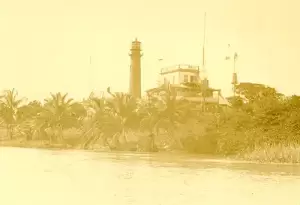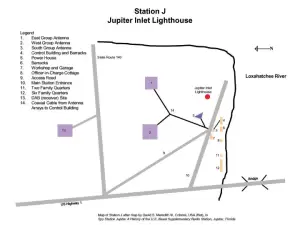U.S. Military in Jupiter

The U.S. Navy first had a presence at the Jupiter Inlet in 1890, when a U.S. Naval Wireless Telegraph Station was established on what was then Fort Jupiter Reservation. Naval Radio Station Jupiter Inlet was authorized as part of a chain of coastal stations created by the navy in the early 1900s; in 1913 the Jupiter station was further authorized to conduct commercial business transactions by radio.
In 1929 the navy acquired 8.4 acres at Jupiter Lighthouse from the U.S. Department of Commerce, which controlled the U.S. Lighthouse Service, and established a Radio Compass Station. The station monitored distress signals and naval ship and aircraft frequencies, broadcasted weather information, and served as a navigational aid. A decade later, when the U.S. Coast Guard managed the site, the navy obtained more land and built a high frequency direction finding (D/F) station nearby.

After April 1940, any pretext of neutrality by the United States was abandoned, and the Jupiter post was acknowledged as an intercept and D/F station. A commissioned officer was sent to command the station, with orders to expand into a “Strategic Observation Post,” which it already was. The Communications Radio Intelligence Unit and Radio Direction Finding Station, known as “Station J,” was operational. It monitored the very low frequencies needed to locate German U-boats, intercepted their radio activity, warned Allied ships, and forwarded intercepted material to Washington for code breaking and translation.
In 1941, with 30 servicemen in residence, the navy received 3.5 more acres to complete the campus and 26 buildings of typical World War II quality, designed to last just five years. The final build-out consisted of two barracks/operations rooms, married quarters for eight families, officer’s cottage, powerhouse, garage, dispensary, ships’ store, shelter for the direction finding radio, and three antenna groupings. Two advanced direction finders were added about two miles south of the station on U.S. Highway One, where the communities of Ocean Walk, Seabrook Place, and the Racquet Club were later developed.
After Japan’s attack on Pearl Harbor brought the U.S. into the war, Station J began an intensive radio monitoring of enemy radio traffic. The leading radiomen were rotated in the evening shift, listening for daily reports from submarines to their bases. In February 1943, the Jupiter station consisted of 95 men, including 12 Marines who arrived as security guards. The commander would have preferred more radiomen; he had the Marines moved to a motel. Thirty German U-boats were destroyed off the Florida coast that May, and 37 in June, many of which had been located by the Communications Radio Intelligence Unit at Station J.
As the war wound down, the decreasing need for the station was evident in the rank of its commanders. A lieutenant was replaced in March 1944 by an ensign, who was replaced a year later by a radio electrician. On July 15, 1945, Station J was decommissioned and was reborn as Coast Guard Radio Station NLM.
After the war ended, unofficial charges were made that President Roosevelt had had prior knowledge of the attack on Pearl Harbor. During the ensuing investigation, two of Station J’s commanders denied that they had been given orders to listen for a “Winds” alert, the Japanese signal that war was commencing.
The married quarters at Station J became offices for a Coast Guard Auxiliary Flotilla. Similar buildings, which may have also come from Camp Murphy (now Jonathan Dickinson State Park), were ferried across the Intracoastal Waterway to Jupiter Island for use as service facilities and servant quarters.
Today the site is owned by the Town of Jupiter, who restored the last remaining “married quarters” building and leased it to the Loxahatchee River Historical Society for its offices and the Jupiter Inlet Lighthouse Museum. In 2008 President George W. Bush designated the entire site of historical significance an “Outstanding Natural Area,” a congressional designation established to protect federal lands that contain unique scenic, scientific, educational, and recreational values for public enjoyment. The Jupiter site was only the second Outstanding Natural Area to be so named; the first, in 2000, was Yaquina Head Lighthouse in Oregon.

